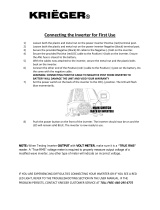
2 | Westinghouse Portable Power
DISCLAIMERS:
All information, illustrations and specications in this manual are based on the latest information available at
the time of publishing. The illustrations used in this manual are intended as representative reference views only.
Moreover, because of our continuous product improvement policy, we may modify information, illustrations and/or
specications to explain and/or exemplify a product, service or maintenance improvement. We reserve the right
to make any change at any time without notice. Some images may vary depending upon which model is shown.
ALL RIGHTS RESERVED:
No part of this publication may be reproduced or used in any form by any means – graphic, electronic or
mechanical, including photocopying, recording, taping or information storage and retrieval systems – without the
written permission of MWE Investments LLC.
DANGER
This manual contains important instructions for operating this generator. For your safety and the safety of others, be sure
to read this manual thoroughly before operating the generator. Failure to properly follow all instructions and precautions
can cause you and others to be seriously hurt or killed.
TABLE OF CONTENTS
TECHNICAL SPECIFICATIONS ..................3
PRODUCT REGISTRATION .....................3
For Your Records: .........................3
Product Registration .......................3
Product Registration Form ...................3
SAFETY .....................................4
Safety Denitions ..........................4
Safety Symbol Denitions ....................4
General Safety Rules ........................5
ASSEMBLY ..................................6
Hooking Up the Battery ......................6
FEATURES ..................................7
Basic Inverter Features .....................7
Control Panel Features ......................8
OPERATION .................................9
Before Starting the Inverter ...................9
Location Selection .......................9
Weather ...............................9
Grounding the Inverter ....................9
High Altitude Operation ...................9
Power Cord ...............................10
Inverter Paralleling Operation .................10
Initial Oil Fill ...............................11
Adding/Checking Engine Fluids and Fuel ........11
Checking and/or Adding Engine Oil ............11
Adding Gasoline to the Fuel Tank ..............12
Starting the Inverter .........................13
Electric Start ...........................13
Manual Start ............................13
Wireless Remote Start ....................13
Stopping the Inverter ........................14
Using Eciency Mode ......................14
Resetting the Reset Breaker ..................14
Programming Remote Start Fob ...............14
MAINTENANCE ..............................15
Maintenance Schedule ......................15
Engine Oil Maintenance .....................16
Checking Engine Oil ........................16
Adding Engine Oil ..........................16
Changing Engine Oil ........................17
Air Filter Maintenance .......................17
Cleaning the Air Filter .....................17
Draining the Float Bowl ......................18
Spark Plug Maintenance .....................18
Cleaning the Spark Arrestor ..................19
Checking and Adjusting Valve Lash ............19
Cleaning the Inverter ........................20
Battery Service ............................20
Storage ..................................21
TROUBLESHOOTING .........................22
EXPLODED AND ENGINE VIEWS ................23
iGen4500 Schematic ........................23
iGen4500 Exploded View ....................24
iGen4500 Engine View ......................26
NOTICE
Even with a carburetor modication, engine horsepower will decrease about 3.5% for each 300 meter (1,000 foot) increase in altitude.
The eect of altitude on horsepower will be greater if no carburetor modication is made. A decrease in engine horsepower will de-
crease the power output of the generator. Contact our service team to order altitude kits. See page 9 for altitude kit numbers.
























